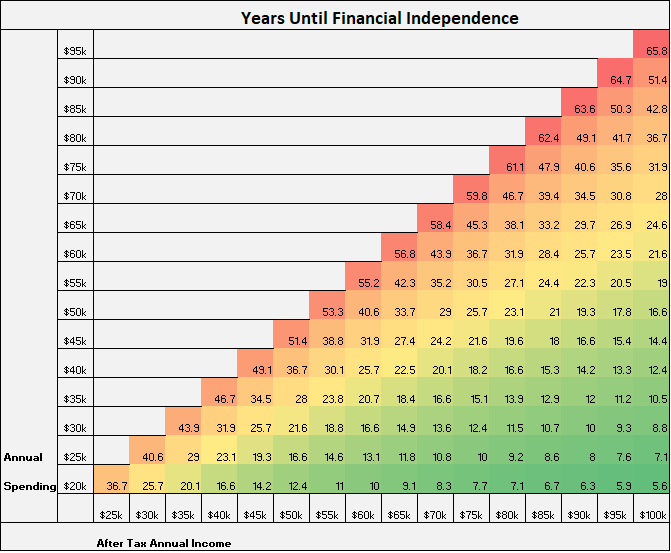While perusing the financial blogosphere on a lazy Sunday, I came across a unique chart called “The Early Retirement Grid.”
The grid’s main purpose is to show long it will take you to retire given various changes in your income and spending levels. It assumes that you start at a net worth of zero, that your investments earn a 5% return, and that you’ll withdraw 4% of your money each year in retirement to pay for your yearly expenses. Take a look:

This deceptively simple image contains a lot of wisdom. It illustrates the dramatic power of spending less and saving more, the danger of lifestyle inflation, the importance of taxes, and almost anything else you can think of related to personal finance.
Mind the Gap
The grid shows that there’s one metric that trumps all others: your savings rate. If you can keep a big gap between your saving and your spending, you can gain financial flexibility much earlier.
What’s so cool is that you don’t need a huge salary to chop years of your retirement age. For example, imagine three different people: Kim, Sam, and Jessie. Kim takes home $80,000 per year after taxes; Sam, $60,000; and Jessie, $40,000.
Let’s say they’re all diligent savers and they put away exactly half of their after-tax income, for a 50% savings rate. Who will attain financial independence first?
Amazingly, it’s a tie. The grid shows that each of them would only need to work 16.6 years to fund their retirement at their current spending levels.
Jessie earns $40,000 less than Kim, yet their retirement timelines are the exact same. One reason is that, the more of your income you save, the less you’re accustomed to living on — which means you’ll need less money in retirement to maintain your existing lifestyle. Meanwhile, someone taking home $100,000 a year after taxes would have to keep working almost 66 years if they spent most of that money each year. This clearly shows that keeping a high savings rate is the biggest lever you can pull in terms of maximizing your financial success.
It also demonstrates the power of resisting lifestyle inflation. If Sam takes home $60,000 and spends $40,000 of it, he’s on pace to work a fairly typical 40-year career. But if he’s able to increase his take-home pay by $10,000, whether through a promotion at work or a side hustle, and he keeps his spending at the same $40,000 a year, he can shave more than 11 years off his work career.
Another interesting aspect of the grid is that it doesn’t crunch numbers for those who spend below $20,000 per year. Think about how many years you could knock off your working life if you only spent $15,000 per year? Or $10,000?
You might think it’s impossible to live on that much, but there are plenty of examples of people making do with even less. Jacob Lund Fisker, author of the popular blog and book “Early Retirement Extreme,” famously lives on $7,000 per year. He’s not a hermit who subsists on ramen noodles, but a thriving, happy and active entrepreneur living in a major metropolis.
Achieving a high savings rate is all about your attitude, your goals, and your creativity. No high-paying job required. I find that highly motivating.
Follow the Yellow-Green Road
When I see things like the early retirement grid, my instinct is to get really excited about saving money. I’ll turn to my wife and say something like: “If we move in with your parents, take night-shift jobs, and scavenge all our food from dumpsters, we can retire in three years!”
My wife reminds me that she’s on board to be frugal, but she’s not willing to sacrifice our short-term happiness in the pursuit of a ridiculously high savings rate.
Of course, I have to agree with her. It’s important to find a lifestyle with balance. What’s great about the early retirement grid is that it provides visual proof that a frugal, but not extreme, lifestyle can still have a big impact on how long you have to work.
The sweet spot of the grid is found in the line of light yellow and green squares that cut through the middle. Each of those squares is in the 16 to 28 years range. They represent how many years you would need to work if you saved between 30% and 50% of your after-tax income. For many people, saving that much is a tough but realistic goal.
Considering the average person works for over 40 years, getting that number down to 28 is no small feat! That represents 12 extra years of your life where you get to do what you want, when you want, on your own terms.
Even if you love your job and you’re one of those “I’d work for free” types, it’s still powerful to gain flexibility. You never know when a recession will hit, when the office culture will change, or when you’ll want to work less to take care of a child or ailing family member. Financial independence is about the freedom that comes with having options, so you’re better able to roll with the punches.
It takes effort to gain that flexibility, but not extreme or demoralizing effort. You don’t have to break your back trying to get your savings rate up near 80% in order to have success. Remember, the perfect is the enemy of the good.
Summing Up
One thing to keep in mind is that financial independence, in this context, means that your investments can cover your yearly expenses. It doesn’t take into account contingencies, such as medical issues or paying for a child’s education. Every person’s situation will be different, so plan accordingly.
That being said, the essential thrust of the grid remains the same: If you can find ways to save a bigger portion of your income, to grow the gap between what you earn and what you spend, you’ll be setting yourself up for financial success. You can cut chunks of years off your working career with relatively small spending reductions, which is amazing to behold.
If you’re trying to check out of the rat race before traditional retirement age, and need a little reminder to keep you motivated, print out the grid and put it on your desk for inspiration. (Well, maybe keep it in a drawer, so you’re not advertising how much you want to call it quits.)
Related Articles:











